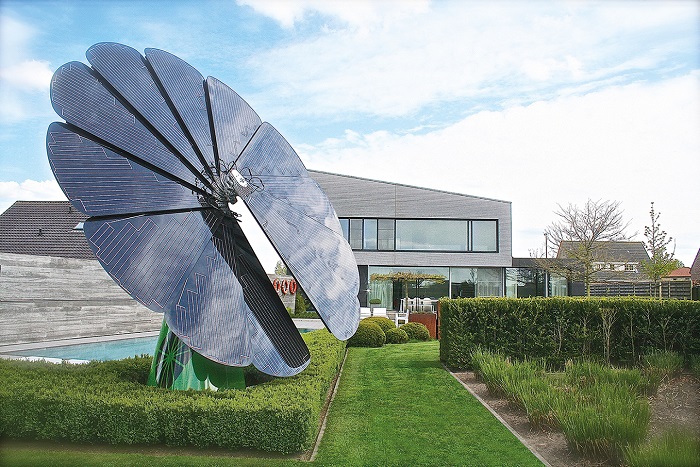New Mars Forums
You are not logged in.
- Topics: Active | Unanswered
Announcement
#526 2021-05-28 13:18:10
- SpaceNut
- Administrator

- From: New Hampshire
- Registered: 2004-07-22
- Posts: 29,433
Re: Going Solar...the best solution for Mars.
So far the highest level of conversion is a triple layer cells that are tailored to catch different bands of light as it passes through them.
perovskite is quite a novel bit of chemistry that is allowing more light to be converted....
Offline
#527 2021-05-29 10:44:32
- tahanson43206
- Moderator

- Registered: 2018-04-27
- Posts: 19,464
Re: Going Solar...the best solution for Mars.
The link below is about success of a Canadian company that is in the solar cell business.
Because the customer cited is in Italy, I decided the item might be of interest to Canadian and Italian members, while at the same time fitting loosely into the theme of this topic ...
What I'm not clear on at this point (pending study of the actual company) is whether the Canadian company is simply importing Chinese parts and perhaps assembling them into complete systems for deployment. That would be good, but making the cells would be better.
https://www.yahoo.com/finance/news/cana … 12918.html
(th)
Offline
#528 2021-06-04 10:29:27
- Mars_B4_Moon
- Member
- Registered: 2006-03-23
- Posts: 9,776
Re: Going Solar...the best solution for Mars.
Solar energy is a free, it will be around for billions of years, a near inexhaustible infinite almost limitless resource, yet harnessing it is a relatively new idea.
Solar irradiance (W/m2) Mars 586.2 Earth 1361.0 Ratio 0.431
https://nssdc.gsfc.nasa.gov/planetary/f … sfact.html
Issues of Living....fixing your solar panels?
How Bad is the Radiation on Mars?
https://www.universetoday.com/14979/mars-radiation1/
Over the course of about 18 months, the Mars Odyssey probe detected ongoing radiation levels which are 2.5 times higher than what astronauts experience on the International Space Station – 22 millirads per day, which works out to 8000 millirads (8 rads) per year. The spacecraft also detected 2 solar proton events, where radiation levels peaked at about 2,000 millirads in a day, and a few other events that got up to about 100 millirads.
Dust Storms???
On Mars an issue could arise too Much Mars Dust and Too Little Power?
NASA’s Mars Lander Cleaned Sand Off Its Solar Panels Using More Sand
https://www.extremetech.com/extreme/323 … -more-sand
Last edited by Mars_B4_Moon (2021-06-04 10:39:12)
Offline
#529 2021-06-04 14:18:43
- louis
- Member
- From: UK
- Registered: 2008-03-24
- Posts: 7,208
Re: Going Solar...the best solution for Mars.
Not sure radiation is relevant to this thread but Mars buildings with regolith cover will afford much greater protection than on the ISS.
Dust storms never completely prevent PV energy generation. Apart from a few days at the beginning dust storms soon settle around the 40% of normal mark for insolation. You adjust your system accordingly and use some of your methane and oxygen generation as emergency power if necessary. But having looked at this in depth, it should never be necessary. The main impact is you will have something of a shortfall in methane and oxygen production - so you either have to scale up your facility or manufacture for a longer period than might otherwise be the case. It's really only going to be a problem for the first couple of missions.
Solar energy is a free, it will be around for billions of years, a near inexhaustible infinite almost limitless resource, yet harnessing it is a relatively new idea.
Solar irradiance (W/m2) Mars 586.2 Earth 1361.0 Ratio 0.431
https://nssdc.gsfc.nasa.gov/planetary/f … sfact.htmlIssues of Living....fixing your solar panels?
How Bad is the Radiation on Mars?
https://www.universetoday.com/14979/mars-radiation1/
Over the course of about 18 months, the Mars Odyssey probe detected ongoing radiation levels which are 2.5 times higher than what astronauts experience on the International Space Station – 22 millirads per day, which works out to 8000 millirads (8 rads) per year. The spacecraft also detected 2 solar proton events, where radiation levels peaked at about 2,000 millirads in a day, and a few other events that got up to about 100 millirads.Dust Storms???
On Mars an issue could arise too Much Mars Dust and Too Little Power?NASA’s Mars Lander Cleaned Sand Off Its Solar Panels Using More Sand
https://www.extremetech.com/extreme/323 … -more-sand
Let's Go to Mars...Google on: Fast Track to Mars blogspot.com
Offline
#530 2021-06-04 16:12:43
- Oldfart1939
- Member
- Registered: 2016-11-26
- Posts: 2,453
Re: Going Solar...the best solution for Mars.
"Dust storms never completely prevent PV energy generation."
False.
Online
#531 2021-06-04 18:52:53
- SpaceNut
- Administrator

- From: New Hampshire
- Registered: 2004-07-22
- Posts: 29,433
Re: Going Solar...the best solution for Mars.
We really need to stop using the Solar irradiance (W/m2) of Mars 586.2 W/m2 as its only number as thats mid summer and its only going to go down as winter approaches.. way down and a dirt covered panel is not going to cut it....
13 Oct 2020 – Mars at opposition
30 Nov 2022 – Mars at perigee
07 Dec 2022 – Mars at opposition
12 Jan 2025 – Mars at perigee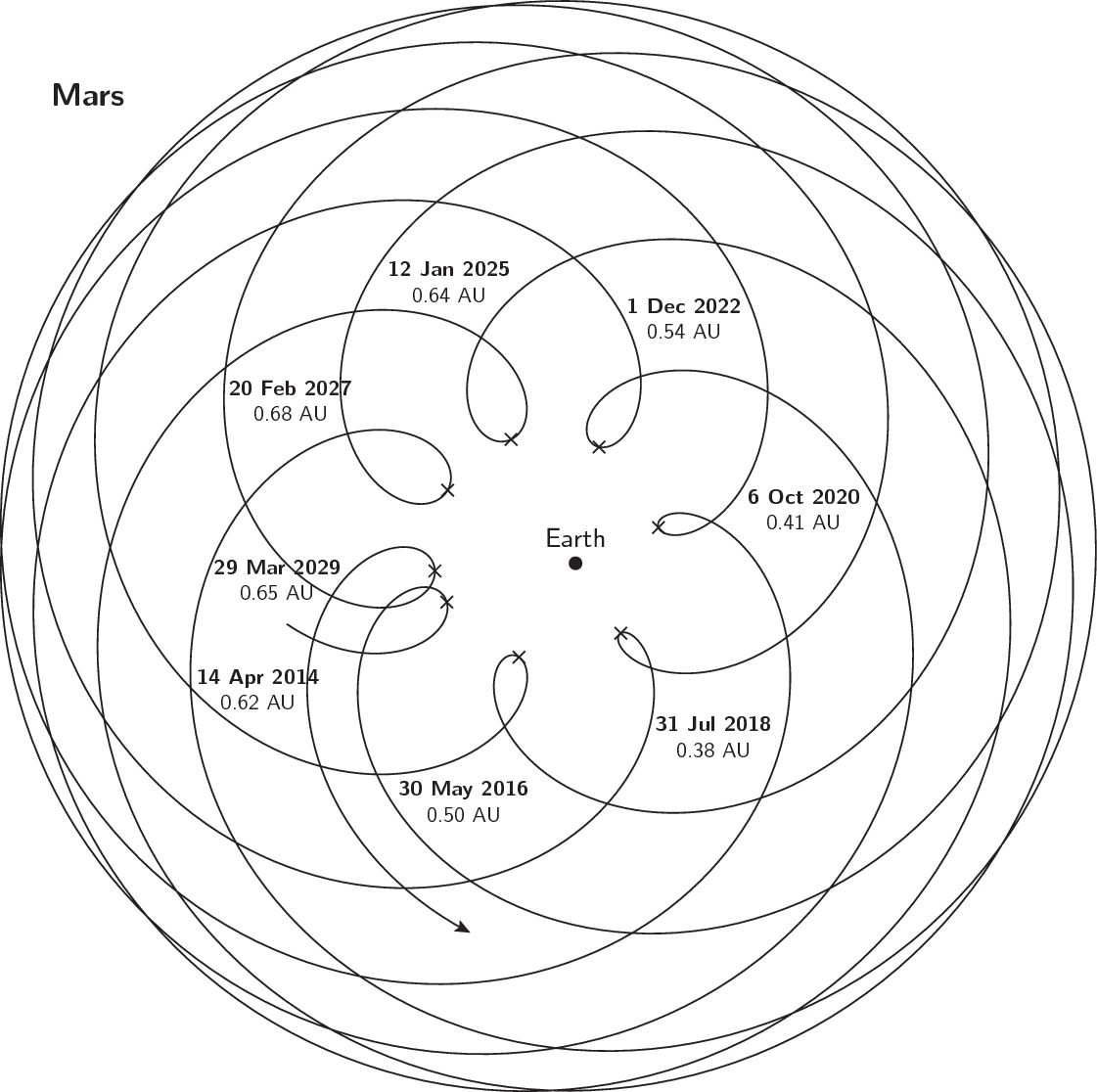

https://ttu-ir.tdl.org/bitstream/handle … 17_175.pdf
Its believed that the mars co2 frost is partly to cause for the levels of dust which occur in the air.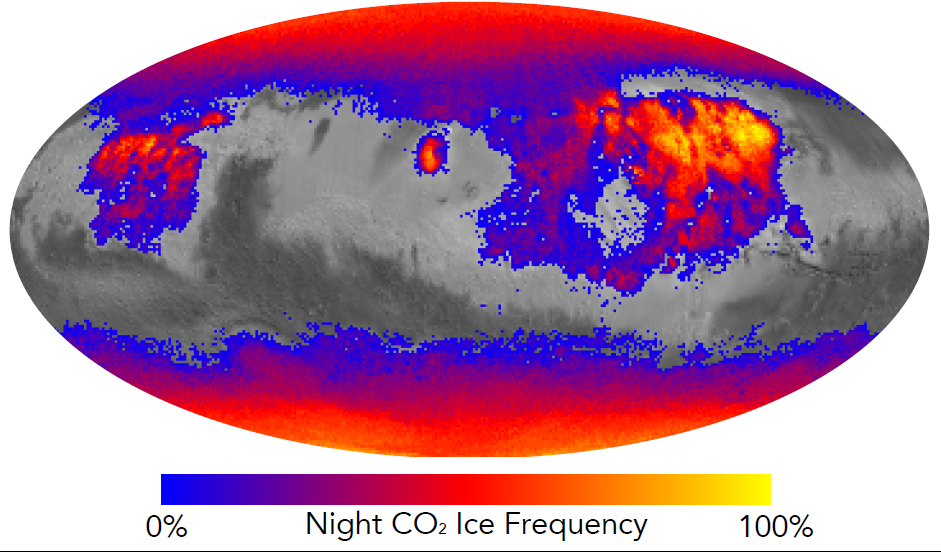
https://www.sciencedirect.com/science/a … 3515000044
https://eos.org/wp-content/uploads/2020 … 0-wide.png
power level drop shows how the panels would see the restricting dust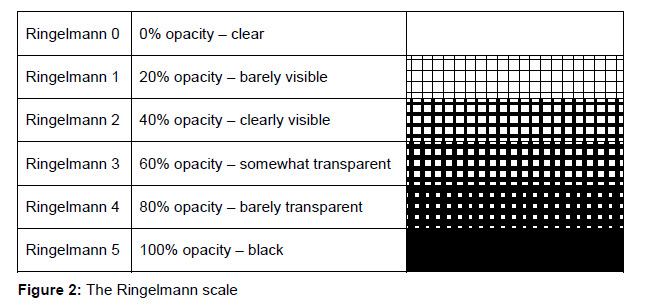
images of the dust rom the dying rover
notice the size of the sun being blocked...
Offline
#532 2021-06-04 18:54:24
- louis
- Member
- From: UK
- Registered: 2008-03-24
- Posts: 7,208
Re: Going Solar...the best solution for Mars.
Well that sentence could be improved by a "will" before "never" because of course up till now small rovers have to shut down during dust storms to protect their energy systems if insolation falls to a low point. But a sizeable PV system on Mars will never be in the position of failing to produce any energy during a dust storm. There's a lot of confusion around this topic with people assuming that increased solar obscurity (which does not translate directly to reduced insolation on the same scale) , reduction in direct insolation (obviously during a dust storm there is a lot more ambient light which compensates), dust on PV panels reducing output (yes, but a large PV system will have dust clearance systems) and the length of dust storms (dust storms only produces periods of very low insolation for a few sols, even if their duration is over months) means PV generation collapses completely.
There is some evidence that dust storms have occasionally reduced insolation to 10% of normal levels though the peak is more normally around 20%. At no time has the reduction been to 0%.
A PV system operating on Mars that has to power a propellant plant facility (say 1MW) can afford to go down to 10% of normal output and still be able to power a base and ensure the survival of humans without any additional emergency energy input.
"Dust storms never completely prevent PV energy generation."
False.
Let's Go to Mars...Google on: Fast Track to Mars blogspot.com
Offline
#533 2021-06-04 19:00:33
- louis
- Member
- From: UK
- Registered: 2008-03-24
- Posts: 7,208
Re: Going Solar...the best solution for Mars.
That photo of the Rover "dying" through lack of insolation is a fake photo. It was admitted it was an artist's rendering. There has never been total obscurity of the sun during a dust storm on Mars. If I'm wrong presumably you can provide a link to show I am wrong.
We really need to stop using the Solar irradiance (W/m2) of Mars 586.2 W/m2 as its only number as thats mid summer and its only going to go down as winter approaches.. way down and a dirt covered panel is not going to cut it....
13 Oct 2020 – Mars at opposition
30 Nov 2022 – Mars at perigee
07 Dec 2022 – Mars at opposition
12 Jan 2025 – Mars at perigee
https://in-the-sky.org/imagedump/book/mars_marsCircles.pnghttp://davidaroffman.com/images/low_mon … 3_2020.png
https://ttu-ir.tdl.org/bitstream/handle … 17_175.pdf
Its believed that the mars co2 frost is partly to cause for the levels of dust which occur in the air.
https://mars.nasa.gov/system/resources/detail_files/7897_co2-carbon-dioxide-frost-form-polar-mars-orbiter-pia20758-full2.jpghttps://www.sciencedirect.com/science/a … 3515000044
https://eos.org/wp-content/uploads/2020 … 0-wide.png
power level drop shows how the panels would see the restricting dust
http://2.bp.blogspot.com/-6tJFJ3FTy-4/U … -16+AM.jpgimages of the dust rom the dying rover
https://d2pn8kiwq2w21t.cloudfront.net/i … h-1024.jpgnotice the size of the sun being blocked...
Let's Go to Mars...Google on: Fast Track to Mars blogspot.com
Offline
#534 2021-06-04 19:13:47
- SpaceNut
- Administrator

- From: New Hampshire
- Registered: 2004-07-22
- Posts: 29,433
Re: Going Solar...the best solution for Mars.
That was the photo of the sun time elapsed for each increase of opacity from the rover before it was turned off in hopes that it might survive.
Offline
#535 2021-06-04 20:03:45
- louis
- Member
- From: UK
- Registered: 2008-03-24
- Posts: 7,208
Re: Going Solar...the best solution for Mars.
It was as you indicated an "image". An artist's rendering. It's not a series of photos. If it was a photo it wouldn't have been black in daylight because there's still plenty of ambient light around in even the worst dust storms during "daylight hours".
That was the photo of the sun time elapsed for each increase of opacity from the rover before it was turned off in hopes that it might survive.
Let's Go to Mars...Google on: Fast Track to Mars blogspot.com
Offline
#536 2021-06-04 20:11:57
- SpaceNut
- Administrator

- From: New Hampshire
- Registered: 2004-07-22
- Posts: 29,433
Re: Going Solar...the best solution for Mars.
This must be another deep fake of the storm as its coming in
June 2018 NASA's Curiosity Rover used its Mast Camera, or Mastcam, to snap photos of the intensifying haziness the surface of Mars, caused by a massive dust storm.
Offline
#537 2021-06-05 18:36:32
- louis
- Member
- From: UK
- Registered: 2008-03-24
- Posts: 7,208
Re: Going Solar...the best solution for Mars.
Nope, those pics are fine because of course you can see things, which is just the way it is in dust storm because there isn't total loss of insolation.
I've seen peak storm satellite and telescope pics of the Mars surface. You can see ground features, so clearly there is not total loss of insolation.
You've just fallen for a myth that is encouraged by a number of media outfits.
This must be another deep fake of the storm as its coming in
https://www.nasa.gov/sites/default/file … k=6UnfoebiJune 2018 NASA's Curiosity Rover used its Mast Camera, or Mastcam, to snap photos of the intensifying haziness the surface of Mars, caused by a massive dust storm.
Last edited by louis (2021-06-05 19:37:47)
Let's Go to Mars...Google on: Fast Track to Mars blogspot.com
Offline
#538 2021-06-05 19:13:06
- SpaceNut
- Administrator

- From: New Hampshire
- Registered: 2004-07-22
- Posts: 29,433
Re: Going Solar...the best solution for Mars.
The eye can see even in the dark when solar produces nothing and so does a panel in only slightly more as it can not produce power until it reaches the junction activation thresholds.
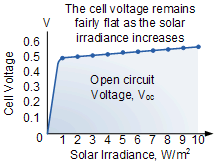

https://www.pveducation.org/pvcdrom/sol … -intensity
If you block light from half of a panel and leave the other half in bright sunlight, you might expect that the power output will drop by half. But that’s not the case. What actually happens is that the power output will drop dramatically - you will lose much more than half the power.
https://www.victronenergy.com/blog/2020 … ow-effect/
While the cell is putting out low level power its the load which is the circuit on the panel that makes it so that no power is coming out of it as the levels of light drop....
So a panel with no circuit is unregulated and you are at the mercy of the outputs loading effects which is current and voltage as soon as the load rises the voltage will drop out and you get nothing....
Offline
#539 2021-06-05 19:43:11
- louis
- Member
- From: UK
- Registered: 2008-03-24
- Posts: 7,208
Re: Going Solar...the best solution for Mars.
Insolation is a measure of solar energy so your comments don't apply.
Low light is not "dark" in this context. Low light is just low light.
In a dust storm a lot of direct insolation is converted into ambient light. Ambient light still powers PV panels/film.
I'm really not sure what you are trying to claim about insolation during dust storms. Are you actually making the absurd claim that it goes down to 0% in normal hours of light? If you aren't making that claim what are you saying? That it goes down to 10%? OK. Then I will ask for how long during a dust storm. One sol? Seven sols? 30 sols?
You are just posting stuff without making clear what your claim is.
The eye can see even in the dark when solar produces nothing and so does a panel in only slightly more as it can not produce power until it reaches the junction activation thresholds.
https://www.alternative-energy-tutorial … r/alt9.gif
https://gcell.com/wp-content/uploads/Lux-levels.jpg
https://www.pveducation.org/pvcdrom/sol … -intensity
If you block light from half of a panel and leave the other half in bright sunlight, you might expect that the power output will drop by half. But that’s not the case. What actually happens is that the power output will drop dramatically - you will lose much more than half the power.
https://www.victronenergy.com/blog/2020 … ow-effect/
While the cell is putting out low level power its the load which is the circuit on the panel that makes it so that no power is coming out of it as the levels of light drop....
So a panel with no circuit is unregulated and you are at the mercy of the outputs loading effects which is current and voltage as soon as the load rises the voltage will drop out and you get nothing....
Let's Go to Mars...Google on: Fast Track to Mars blogspot.com
Offline
#540 2021-06-08 19:41:13
- SpaceNut
- Administrator

- From: New Hampshire
- Registered: 2004-07-22
- Posts: 29,433
Re: Going Solar...the best solution for Mars.
https://www.quote.com/solar/how-solar-cells-work/
https://www.acs.org/content/acs/en/educ … works.html
A solar cell is made of two types of semiconductors, called p-type and n-type silicon. The p-type silicon is produced by adding atoms—such as boron or gallium—that have one less electron in their outer energy level than does silicon. Because boron has one less electron than is required to form the bonds with the surrounding silicon atoms, an electron vacancy or “hole” is created.
The n-type silicon is made by including atoms that have one more electron in their outer level than does silicon, such as phosphorus. Phosphorus has five electrons in its outer energy level, not four. It bonds with its silicon neighbor atoms, but one electron is not involved in bonding. Instead, it is free to move inside the silicon structure.
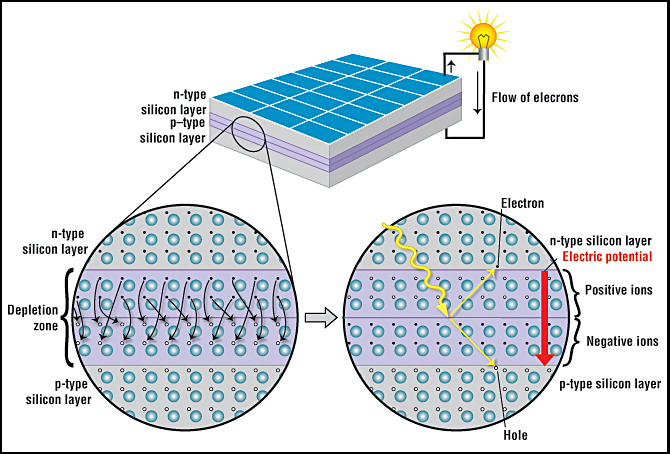
Photovoltaics is the direct conversion of light into electricity at the atomic level. Some materials exhibit a property known as the photoelectric effect that causes them to absorb photons of light and release electrons. When these free electrons are captured, an electric current results that can be used as electricity.
photovoltaic response of single-junction cells is limited to the portion of the sun's spectrum whose energy is above the band gap of the absorbing material, and lower-energy photons are not used. One way to get around this limitation is to use two (or more) different cells, with more than one band gap and more than one junction, to generate a voltage.
Only a certain amount of energy, measured in electron volts (eV) and defined by our cell material (about 1.1 eV for crystalline silicon), is required to knock an electron loose. The optimal band gap, balancing these two effects, is around 1.4 eV for a cell made from a single material.
Maximum voltage produced by a single solar cell is 0.5 to 0.6 Volts after the steering diode is accounted for.
Offline
#541 2021-06-19 20:19:32
- SpaceNut
- Administrator

- From: New Hampshire
- Registered: 2004-07-22
- Posts: 29,433
Re: Going Solar...the best solution for Mars.
The massive amounts of solar panels on the ISS are collecting 215 kws of power and yet we are not growing any food and need to supplement both water, air for the crew of typically less than 7...
ISS has an internal pressurized volume of 32,333 cubic feet
Each of the eight solar arrays is 112 feet long by 39 feet wide.
The four sets of arrays can generate 84 to 120 kilowatts of electricity
They get hit with 1300 watts for each meter square.
That said we are going to need even more power than the station for any mars settlements or crewed landings.
Offline
#542 2021-06-20 06:20:57
- louis
- Member
- From: UK
- Registered: 2008-03-24
- Posts: 7,208
Re: Going Solar...the best solution for Mars.
I think 1 MwE constant or constant equivalent is a reasonable guesstimate for the power requirement on Mars. That might mean you need something that can generate something like 34,000 KwHs per sol.
The massive amounts of solar panels on the ISS are collecting 215 kws of power and yet we are not growing any food and need to supplement both water, air for the crew of typically less than 7...
ISS has an internal pressurized volume of 32,333 cubic feetEach of the eight solar arrays is 112 feet long by 39 feet wide.
The four sets of arrays can generate 84 to 120 kilowatts of electricity
They get hit with 1300 watts for each meter square.That said we are going to need even more power than the station for any mars settlements or crewed landings.
Let's Go to Mars...Google on: Fast Track to Mars blogspot.com
Offline
#543 2021-06-20 06:50:26
- tahanson43206
- Moderator

- Registered: 2018-04-27
- Posts: 19,464
Re: Going Solar...the best solution for Mars.
For Louis re #542
Can you keep your thought process going?
Your one megawatt baseline seems (to me for sure) like a reasonable starting point for a fact based presentation that would stand up to scrutiny by your fellow forum contributors.
Calliban, in particular, has offered the point of view that the energy available from a solar array is insufficient to maintain itself, let alone create a new one.
The entire concept of automated replication depends upon the premise that there is sufficient solar energy available in a location to deliver a small energy profit after maintenance is accounted for.
In post #642 you have shown a hint of willingness to do actual computations based upon actual facts.
If you can keep that impulse going, it would (could) lead to a presentation that can withstand the withering criticism it is guaranteed to "enjoy".
(th)
Offline
#544 2021-06-20 08:05:59
- SpaceNut
- Administrator

- From: New Hampshire
- Registered: 2004-07-22
- Posts: 29,433
Re: Going Solar...the best solution for Mars.
iss numbers need array size adjustment for lower input of 1300/430 =3 to just achieve what the iss produce. which is 2,580 kwhrs a day. using the same convertors//inverters and battery units.
array is 8 x (112 feet long by 39 feet wide) x 3 = 104,832 sq ft
The iss gets 12 hours of light exposure where as placing them on the surface of mars will be closer to 9 hours of useful intensity for the panels to gather photons..
so in actuality the array would only see 1,935 kwhrs
Those arrays see the max of 240 kw during the half of the year when we are close to the sun and only 196 kw in the second half when we are farthest away.
mars closest is 430 w but mars farthest away is closer to 300 w
Offline
#545 2021-06-20 11:52:54
- Mars_B4_Moon
- Member
- Registered: 2006-03-23
- Posts: 9,776
Re: Going Solar...the best solution for Mars.
I wonder also about beaming energy to Mars, say from Mercury beam photons or electronic radition power to Mars, or perhaps we can look at concepts look at the old ideas from Russia one time had an idea to illuminate an area of siberia which seen long winter months, in reallife not Scifi you have these Giant Sun Mirrors of Rjukan they direct Sunlight into a hidden European Norway town, even if it does not grow crops it boosts the Norweigan peoples morale and even develops a tourist site during the long winters. The 'Solspeilet' project is what is was called. Its become a money maker for them and people in other Nordic regions visit Rjukan to stand in the light of the Solspeilet to increase their happiness.
Last edited by Mars_B4_Moon (2021-06-20 12:10:31)
Offline
#546 2021-06-20 12:25:55
- Calliban
- Member
- From: Northern England, UK
- Registered: 2019-08-18
- Posts: 3,804
Re: Going Solar...the best solution for Mars.
I wonder also about beaming energy to Mars, say from Mercury beam photons or electronic radition power to Mars, or perhaps we can look at concepts look at the old ideas from Russia one time had an idea to illuminate an area of siberia which seen long winter months, in reallife not Scifi you have these Giant Sun Mirrors of Rjukan they direct Sunlight into a hidden European Norway town, even if it does not grow crops it boosts the Norweigan peoples morale and even develops a tourist site during the long winters. The 'Solspeilet' project is what is was called. Its become a money maker for them and people in other Nordic regions visit Rjukan to stand in the light of the Solspeilet to increase their happiness.
Mercury's distance from Mars varies between 1.2 - 1.8AU (180-270 million km). To transmit power over that distance to any practical size receiver station, would require beam coherence far beyond anything possible at present. Solar power satellites in orbit about Mars are possible.
"Plan and prepare for every possibility, and you will never act. It is nobler to have courage as we stumble into half the things we fear than to analyse every possible obstacle and begin nothing. Great things are achieved by embracing great dangers."
Offline
#547 2021-06-20 14:58:24
- SpaceNut
- Administrator

- From: New Hampshire
- Registered: 2004-07-22
- Posts: 29,433
Re: Going Solar...the best solution for Mars.
Even if you could make the beam as strong as those coming from the sun the energy to mars would still be 430 w m^2 from that transmission of power....
Face it mars is at a solar deficit of 500 to 700 w m^2 if earths energy levels are needed to be had....
each person at a min needs 400 m^2 of food growing area for on earth is 1kwm^2 x 400 = 400 kw x 9 plus hrs a day 3,600 kwhrs per crew member
Of course once animals get introduced the acreage is even greater...
Water is still another energy hog as we will need to use lots of it to get it from the small amounts which mars has shown thus far.
Offline
#548 2021-06-24 06:37:30
- NewMarsMember
- Member
- Registered: 2019-02-17
- Posts: 1,388
Re: Going Solar...the best solution for Mars.
This contribution is from GW Johnson who remains without a computer for the present ...
This document provides assessment of the dust problem for solar panel users on Mars.
I see a glimpse of a possible future solution with the ability of Ingenuity to direct a blast of air at objects directly below.
However, Ingenuity is not available for Insight.
Well, the following article from AIAA's "Daily Launch" email newsletter is very pointedly illustrative of why solar power on Mars is NOT just rolling out some panels and sitting back harvesting energy! Note that they are NOT talking about degraded insolation due to dust in the air, they are talking about degraded reception of that light due to dust laying on the panels. An actual dust storm would kill the probe (in its current condition) almost immediately.
Outfits on Mars will have to expend considerable effort cleaning dust off those panels, or else we have to design and develop machinery (that does not currently exist) that can do it for them. Once developed, that machinery still costs more weight to send there and requires some of the harvested energy to run. Doing it with human effort costs extra food and oxygen to support the efforts, and those cost weight to send them there, too. Or else the equipment and facilities by which to create them in situ.
Either way you pay, because none of that will be cost-free or weightless. Nuclear reactors might not look so excessively heavy or dangerous, once you figure all this in, with the hazards of humans working in spacesuits to set any of this up.
GW
from "Daily Launch" for 6-23-2021:
Dust Accumulation Could Force End Of InSight Mission
Space News (6/22, Subscription Publication) reports that “dust accumulation on the solar panels of NASA’s InSight Mars lander is reducing the power to the spacecraft and could force the mission to end within a year.” During a meeting of NASA’s Mars Exploration Program Analysis Group on Monday, Bruce Banerdt, principal investigator for the InSight mission at NASA’s Jet Propulsion Laboratory, “said dust accumulating on the lander’s two solar panels has drastically reduced the amount of power they produce, requiring some instruments to be turned off at least temporarily.” Banerdt said, “The dust accumulation on the solar arrays has been considerable. We have about 80% obscuration of the arrays.” According to data presented by Banerdt, “the amount of energy available to the lander per Martian day, or sol, has dropped from nearly 5,000 watt-hours shortly after its November 2018 landing to less than 700 watt-hours now.”
(th)
Recruiting High Value members for NewMars.com/forums, in association with the Mars Society
Offline
#549 2021-06-24 17:54:22
- louis
- Member
- From: UK
- Registered: 2008-03-24
- Posts: 7,208
Re: Going Solar...the best solution for Mars.
Total red herring.
Nothing like the long lived rovers which simply wiggle their panels to get rid of excess dust. Clearly a design fault with Insight.
In any case I personally have never proposed a PV powered mission to Mars that would not include panel/film cleaning. Generally I think mobile robots blowing off the dust is the best solution but there are other solutions e.g. if PV film was hung on wires, you could twang the wires to clear the dust.
This contribution is from GW Johnson who remains without a computer for the present ...
This document provides assessment of the dust problem for solar panel users on Mars.
I see a glimpse of a possible future solution with the ability of Ingenuity to direct a blast of air at objects directly below.
However, Ingenuity is not available for Insight.
Well, the following article from AIAA's "Daily Launch" email newsletter is very pointedly illustrative of why solar power on Mars is NOT just rolling out some panels and sitting back harvesting energy! Note that they are NOT talking about degraded insolation due to dust in the air, they are talking about degraded reception of that light due to dust laying on the panels. An actual dust storm would kill the probe (in its current condition) almost immediately.
Outfits on Mars will have to expend considerable effort cleaning dust off those panels, or else we have to design and develop machinery (that does not currently exist) that can do it for them. Once developed, that machinery still costs more weight to send there and requires some of the harvested energy to run. Doing it with human effort costs extra food and oxygen to support the efforts, and those cost weight to send them there, too. Or else the equipment and facilities by which to create them in situ.
Either way you pay, because none of that will be cost-free or weightless. Nuclear reactors might not look so excessively heavy or dangerous, once you figure all this in, with the hazards of humans working in spacesuits to set any of this up.
GW
from "Daily Launch" for 6-23-2021:
Dust Accumulation Could Force End Of InSight Mission
Space News (6/22, Subscription Publication) reports that “dust accumulation on the solar panels of NASA’s InSight Mars lander is reducing the power to the spacecraft and could force the mission to end within a year.” During a meeting of NASA’s Mars Exploration Program Analysis Group on Monday, Bruce Banerdt, principal investigator for the InSight mission at NASA’s Jet Propulsion Laboratory, “said dust accumulating on the lander’s two solar panels has drastically reduced the amount of power they produce, requiring some instruments to be turned off at least temporarily.” Banerdt said, “The dust accumulation on the solar arrays has been considerable. We have about 80% obscuration of the arrays.” According to data presented by Banerdt, “the amount of energy available to the lander per Martian day, or sol, has dropped from nearly 5,000 watt-hours shortly after its November 2018 landing to less than 700 watt-hours now.”(th)
Let's Go to Mars...Google on: Fast Track to Mars blogspot.com
Offline
#550 2021-06-24 18:59:57
- SpaceNut
- Administrator

- From: New Hampshire
- Registered: 2004-07-22
- Posts: 29,433
Re: Going Solar...the best solution for Mars.
scientific fact was stated for the performance which does not change by anything but a mass increase and design alteration to see if it will work.
The rovers did last so long as the demand was for power was not taken for granted and was monitored for when the saved values were on the decrease due to dust build up. Some would come off from the rough ride but more was also removed by dust devils. It was the combination which allow for the life of the rovers to continue until energy demands versus energy received were negative....
Here is how to defeat the dust and gain 30% solar for each sol plus by moving to track the sun.
During daylight hours, the solar panel petals track the sun’s movement in the same way that it’s inspirational yellow flowers do. During the night, the petals simply spiral in on top of each other and fold down to minimize space. If it’s rainy or windy, the solar system is smart enough to keep its petals hidden to protect itself.

I would add an enclosure to the petals so as to make a means to keep dust from collecting during the night. I would also use a small tank of collected mars air to blow across the panels once in the enclosure venting the dust once they are collapse for the night.
The oscillating face of the flower allows it to create 40 percent more energy than comparable panels. Stationary panels are, by their nature, unable to soak up the same amount of sun and can’t compete with the SmartFlower. Additionally, every time Smartflower unfurls, tiny brushes clean the surface of each panel, diminishing residue and further increasing efficiency.
problem solved and fixed for mars use.....
Offline
